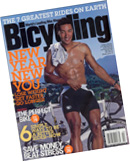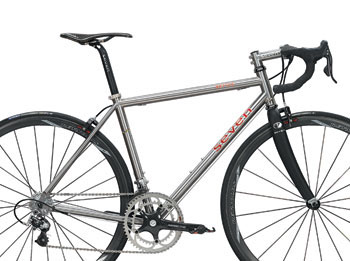Bicycle Frame Manufacturer Seven Cycles Inc. Takes a Ride to the Top of the Industry
by Roberta Holland, Journal Staff
Watertown All Rob Vandermark remembers about his first bicycle is that it was a cheesy gold color and a hand-me-down from his older brother. Vandermark, founder and president, and his colleagues at Seven Cycles Inc. are hoping the bikes they design and manufacture are a little more memorable.
According to company officials, Watertown-based Seven Cycles has become the largest custom-order bike frame manufacturer in the country, selling road and mountain bike frames to retailers who then put the bicycles together using brakes, gears and tires from other manufacturers.
Approaching its second anniversary in January, Seven Cycles had revenue of $520,000 in its first year. The company hit $1.1 million in 1998 sales on November 18 (1998), with total sales for year projected at $1.25 million.
“We started off kind of slow, and nervous, and we opened up pretty widely as the seasons peaked,” said Vandermark. “Some reviews came out and we started getting some exposure.”
Vandermark, 31, said the company is turning a profit despite his initial projections that it wouldn’t be profitable until 1999.
Seven’s frames are not for penny-pinchers. The frames alone cost about $3,000. The company also sells stems for about $350 and forks for around $325. When put together with the other elements, a typical bicycle costs more than $5,000.
Seven does not charge more for custom design. Customers ordering a custom frame fill out a survey that asks for everything from inseam and forearm measurements to questions about flexibility and whether they experience any back or neck pain.
“Seven tries to make the best product possible,” Vandermark said. “Price and cost are secondary to trying to push innovation.”
The company is located in a 7,000-square-foot rented warehouse in Watertown, of which Seven sublets 2,000 square feet. The private company has 12 full-time and three part-time employees.
Vandermark said he first became interested in bikes because his older brother was. But he stuck with it, working in a bike shop throughout high school and college and competing in local races.
Vandermark had been studying to be a sculptor at Massachusetts Colege of Art and the Museum of Fine Arts School when he dropped out in 1987. Answering a help wanted ad, Vandermark got a job with Merlin Metalworks Inc. in Cambridge, which was just getting started at the time, and is now a giant in lightweight titanium frame bikes.
Vandermark worked as a machinist, welder and product developer during his 10 years at Merlin. When Vandermark was at Merlin, he designed the bicycle Greg LeMond used to win the 1989 Tour de France.
When Vandermark split from Merlin in 1997, he took three co-workers with him. Now a total of 11 Seven employees, including Vandermark, came from Merlin.
He started Seven, with the help of two angel investors, who contributed more than $200,000 to help purchase equipment and to print the company’s brochure. Seven incorporated in January 1997 and shipped its first order for 20 bikes that March. The company benefited from some glowing reviews in trade publications and business took off from there.
Seven has 50 distributors throughout the United States and 12 overseas in Italy, France and Hong Kong. About 10 percent of the company’s sales are international.
“They’re kind of at the top of the food chain in terms of quality,” said Scott Fader, a sales executive at Belmont Wheel Works, Seven’s largest retailer. “They have an outstanding level of dealer support and they take care of the customer extremely well, making a bike ride the way a customer wants.”
Fader said the company has combined state-of-the-art technology with old-school craftsmanship.
Vandermark is set to begin another round of financing, and plans to again turn to angel investors in hopes of getting at least another $200,000. With it, he plans to expand Seven’s manufacturing capacity.
Many customers are professionals between the ages of 35 and 55, the younger snowboard crowd and women seeking a bike that fits their proportions.
While company employees joke that the company gets its name because people there work seven days a week, Vandermark said they just liked the number and its positive associations.
Vandermark said that the four original employees—himself, Jennifer Miller, Matt OKeefe and Lisa Rodier—had a combined 36 years of experience, which helped the company avoid a lot of mistakes and missed opportunities. Vandermark sheepishly admitted he is the only member of the company who doesn’t bike to work.
Ashley Korenblat, former president of Merlin and now owner of Western Spirit Cycling Co. in Moab, Utah, was Seven’s first customer.
“What they’ve done is really incredible,” Korenblat said. “You notice (the difference) and then you’re ruined if you go back to riding another bike. The performance is totally noticeable, even to an intermediate rider.”


